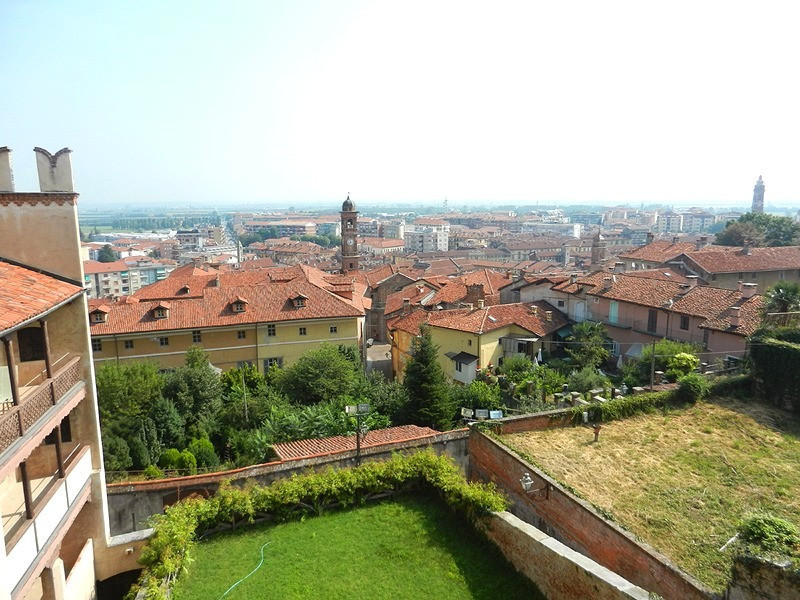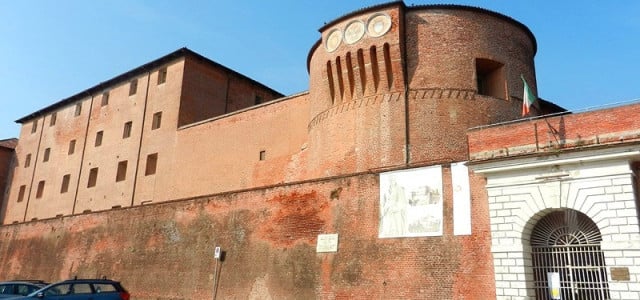Saluzzo
Saluzzo (Italian pronunciation: [saˈluttso]) is a town and former principality in the province of Cuneo, Piedmont region, Italy. The city of Saluzzo is built on a hill overlooking a vast, well-cultivated plain. Iron, lead, silver, marble, slate etc. are found in the surrounding mountains. It has a population of approximately 17,000. Saluzzo was the birthplace of the writer Silvio Pellico and of typographer Giambattista Bodoni. History Saluzzo (Salusse in Piemontese, Saluces in French) was a civitas (tribal city state) of the Vagienni, or mountain Ligures, and later of the Salluvii. This district was brought under Roman control by the Consul Marcus Fulvius. In the Carolingian age it became the residence of a count; later, having passed to the Marquesses of Susa, Manfred I, son of Marquess Bonifacio del Vasto, on the division of that principality became Marquess of Saluzzo; this family held the marquisate of Saluzzo from 1142 to 1548. The marquisate embraced the territory lying between the Alps, the Po and the Stura, and was extended on several occasions. In the Middle Ages it had a chequered existence, often being in conflict with powerful neighbours, chiefly the Counts (later Dukes) of Savoy. After Manfred II's death, his widow had to accept a series of tributes, which were to be later the base of the House of Savoy's claims over the increasingly feebler marquises' territories. Thomas III, a vassal of France, wrote the romance Le chevalier errant ('the knight-errant'). Ludovico I (1416–75) started the Golden Age of the city and imposed himself as a mediator between the neighbouring powers. Ludovico II constructed a tunnel, no longer in use, through the Monviso, a remarkable work for the time. With the help of the French he resisted a vigorous siege by the Duke of Savoy in 1486, but in 1487 yielded and retired to France where he wrote L'art de la chevalerie sous Vegèce ("The art of chivalry under Vegetius", 1488), a treatise on good government, and other works on military affairs. He was a patron of clerics and authors. In 1490 Ludovico regained power, but after his deaths his sons struggled longly for the rule and impoverished the state. After long struggles for independence, the marquisate was occupied (1548) by the French, as a fief of the Crown of France - with the name of Saluces - and remained part of that kingdom until it was ceded to Savoy in 1601. In 1588 Charles Emmanuel I of Savoy took possession of the city. Thenceforward Saluzzo shared the destinies of Piedmont, with which it formed "one of the keys of the house" of Italy. The Marquisate of Saluzzo is the setting of Boccaccio's tale of Griselda, the final story in the Decameron, as well as Chaucer's Clerk's Tale in The Canterbury Tales [1]. Main sights The Cathedral (1491–1501), in Lombard-Gothic style. The façade is decorated with rose-windows, frescoes (almost totally faded) and statues. The interior contains a magnificent Baroque high altar, plus a 16th-century terracotta group portraying the Deposition, ad Adoration of the Shepherds by Sebastiano Ricci. The church of St. Bernard, formerly belonging to the Conventuals, has interesting tombs of the counts della Torre. The Dominican church of San Giovanni, begun in 1330 in Gothic style and completed in 1504 with Bramantesque influences. It has a noteworthy Gothic façade. The apse, from 1504, houses a Funerary Chapel of Ludovico II, work by Antoine Le Moiturier (1425–74) covered with green stone and characterized by an elegant play of arches and sculptures. The sepulchre of Ludovico II is a Renaissance work by Benedetto Briosco. Annexed are the Gothic cloister and the Capitular Hall with the Mausoleum of a vicar-general of the marquisate, Galeazzo Cavassa di Carmagnola, a Renaissance work by Matteo Sanmicheli. The Casa Cavassa, site of the civic museuam and rebuilt with a typical Renaissance interior. The churches of St. Augustine and St. Bernardino are also worthy of note. The present Town hall is the former Jesuit College, while the older one (1462), with a bold tower, is utilized by the Court of Assizes. The 16th century Villa Belvedere has elegant rooms with late-Renaissance decorations. Notable people Carlo Alberto Dalla Chiesa Michele Antonio di Saluzzo Silvio Pellico, writer Giambattista Bodoni, typographer Corrado Segre, mathematician Federico Lombardi, Jesuit priest, director of Radio Vatican Pier Paolo Maggiora Luciano Nizzola, soccer dirigent Paolo De Chiesa, skier Magda Olivero, singer Isacco Levi, partisan See also List of Margraves of Saluzzo Diocese of Saluzzo Beato Giovanni Giovenale Ancina Saluzzo Race Walking School External links Saluzzo turistica, official Saluzzo tourist webpage. Sources This article incorporates text from a publication now in the public domain: Herbermann, Charles, ed. (1913). "Saluzzo". Catholic Encyclopedia. Robert Appleton Company. L'Italia da scoprire, Guide di Bell'Italia, ed. Giorgio Mondadori, 2006



